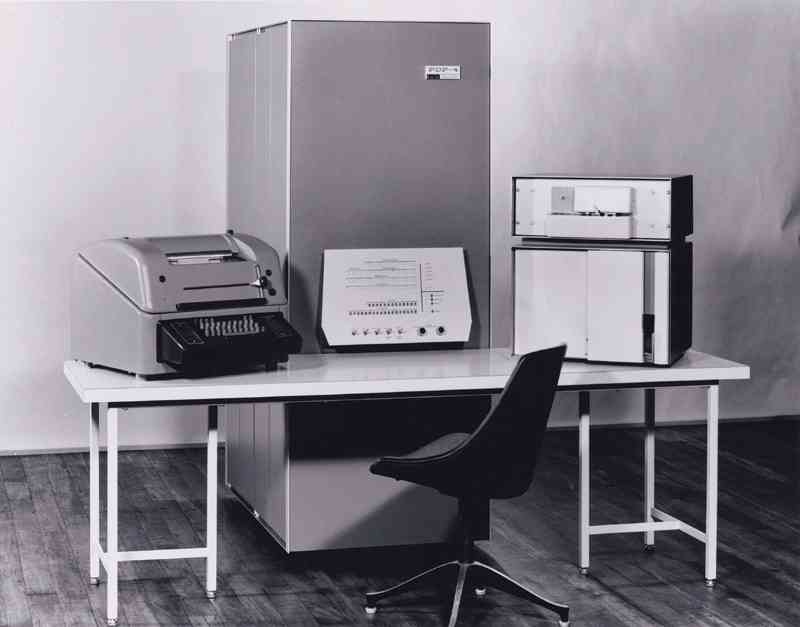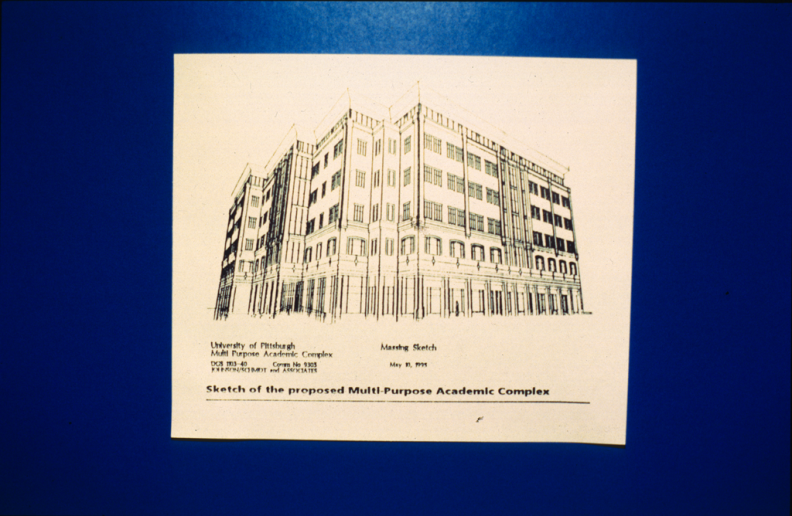Introduction
In 1966, Dr. Orrin E. Taulbee left Goodyear Aerospace Corporation to join the University of Pittsburgh as chairperson of its newly approved Department of Computer Science. Pitt's CS Department (CSD) was among the first such departments in the country. In 1996, its faculty, students, and staff proudly celebrated the thirtieth anniversary of its founding.
Following is an historical sketch of the CSD. A review of its development during its first 30 years suggests a history consisting of three successive 10-year phases.
1966-76: The Formative Years
The CSD was initially located on the 8th floor of the Cathedral of Learning. Orrin Taulbee was faced with a number of challenges. Besides having to recruit faculty qualified in CS, at a time when PhD holders in CS were not to be found, he had to provide suitable computing facilities for both faculty and students. Further, the degree programs themselves had to be designed and implemented. As was typical of many early, university-based CS departments, the graduate degree(s) preceded the undergraduate degree. At Pitt, the order and timing of their establishment were:
- MS program in 1966/67
- PhD program in 1970
- BS program in 1974
In each case, a detailed proposal had to be written, required resources had to be justified, and approval had to be obtained from the relevant councils of the University.
Among the first half dozen (tenured/tenure-stream) faculty recruited, including the Chair himself, only three remained with the CSD for a long time: Orrin Taulbee served as the Dept Chair for 18 years (1966-1984), a remarkably long duration in that position; he died in 1987. Casimir Borkowski joined the faculty in 1967 and also died in 1987. Thomas Dwyer arrived in 1968 and retired in 1993. Among the CSD faculty still on board in 1996, the "longest timer" was Alfs Berztiss whose tenure-stream appointment started in 1970.
With regard to computing facilities, the CSD was at its outset totally dependent on Pitt's Computer Center. The primary computers were an IBM 7090/1401 configuration and two IBM 360/50s, one of which operated under the home-grown Pittsburgh Time-Sharing System (PTSS). Keypunch machines, batch processing, and waiting in lines at the I/O desk to submit jobs and to obtain printed outputs were the norm for our students in those early years. Only some users (mainly faculty with grant support) were fortunate enough to acquire a terminal and a pair of modems to enable interactive access to the PTSS. Reliability of the systems was not close to what we experience and expect today.
 The CSD did manage to acquire its own stand-alone computer. This was a DEC PDP-4 with a price tag of nearly $90k. Among its attractions for students was a "space war" game as well as the "New Tron of Minsky." The latter moved three dots around on the screen in various elliptical patterns based on a number entered by the user via the accumulator switches. Students enjoyed playing these early versions of video games. According to Bob Hoffman (our senior technical staff member) and for trivia buffs: only 45 PDP-4's were ever built and ours had serial no. 32.
The CSD did manage to acquire its own stand-alone computer. This was a DEC PDP-4 with a price tag of nearly $90k. Among its attractions for students was a "space war" game as well as the "New Tron of Minsky." The latter moved three dots around on the screen in various elliptical patterns based on a number entered by the user via the accumulator switches. Students enjoyed playing these early versions of video games. According to Bob Hoffman (our senior technical staff member) and for trivia buffs: only 45 PDP-4's were ever built and ours had serial no. 32.
In about 1969, certain computer users from other Pitt departments felt that the Computer Center services were less than satisfactory. They complained that CS faculty were (allegedly) accorded special, unfair privileges in their access to and manipulation of Computer Center facilities. Consequently, after high-level hearings were conducted, Pitt decided that Orrin Taulbee's dual role of chairing the CSD while also directing the Computer Center would be discontinued. Thereafter he served exclusively as CSD Chair.
This separation meant that the CSD had to become increasingly self-reliant with regard to computing. Accordingly, in 1974, a DEC PDP-11/40 (or GT-44) system was purchased for nearly $50k. It became the hub of all hands-on, Department-internal computer use, both by graduate students (e.g. on class projects) and by faculty.
Also in 1974, the CSD moved into the renovated space of Alumni Hall, which had been occupied for many years by Chemistry. It seemed like a nice improvement. The faculty size stood at 13 T/TS faculty and things were progressing well. Little did we know what would hit us over the next ten years, starting around 1976.
1976-86: The Enrollment Crunch
America's bicentennial year somehow triggered an astonishing upward spiral in the number of students wanting to major in CS. This love affair lasted throughout the United States until the mid-1980's. The number of undergraduate degrees awarded by the CSD at Pitt increased steadily from 1976 until 1985. In fact, during the latter year the CSD produced over 250 graduates (CAS and CGS combined), a larger number than any other department in the Arts & Sciences.
Needless to say, it was extremely difficult to cope with such a surge. The size of the full-time faculty remained essentially unchanged during this time period. More and more part-time faculty had to be hired and the number of teaching assistantships also had to be increased significantly. It became necessary for us to institute a random drawing scheme for deciding on which majors would be permitted to register for which of our advanced undergraduate courses. We simply did not have enough class slots to accommodate all student needs and wishes.
 While it was fun to be that popular as a department, it was a draining experience and left faculty with less than sufficient time to attend to their other responsibilities, especially their research. One bright spot during this 10-year period occurred in 1983: the FAS Dean authorized acquisition of a VAX 11/780 for the CSD. The system cost nearly $250,000. In view of the tremendous amount of tuition revenue that the CSD was bringing in to Pitt, it seemed only fair and well-deserved that we obtain our own VAX.
While it was fun to be that popular as a department, it was a draining experience and left faculty with less than sufficient time to attend to their other responsibilities, especially their research. One bright spot during this 10-year period occurred in 1983: the FAS Dean authorized acquisition of a VAX 11/780 for the CSD. The system cost nearly $250,000. In view of the tremendous amount of tuition revenue that the CSD was bringing in to Pitt, it seemed only fair and well-deserved that we obtain our own VAX.
Then, in 1984, Pitt carried out a review of its academic programs as part of a major planning process. In the Recommendations for Academic Priorities (Faculty Task Force on Planning, University of Pittsburgh, October 1984), the following appeared:
The Department of Computer Science has experienced a phenomenal increase in majors in recent years, and its SCHs [student credit hours] have increased by a factor of five over the past decade. [Yet] the number of full-time faculty has remained constant ...
It was, therefore, recommended in A Report to Trustees, June 1985: The University Plan, that the CSD "should have a large increase in resources" both to accommodate the high student demand as well as to enable expansion of its research. Indeed, as a result, Pitt committed to FAS recruitment of a new chair as well as six new faculty positions.
1986-1996: Toward Excellence
That commitment was honored. Over the next decade, the faculty grew to 20 T/TS positions. However, most remarkable was the increase in quality that resulted. Following are some indicators of achievement as observed in the fall of 1996:
- Research Productivity: The average number of publications per faculty member per year had increased to nearly 7.
- External Research Support: Between 1995 and 1996, the faculty collectively were awarded new or renewed external research grants in the amount exceeding $3,200,000. This was funding channeled through the Department only. Including the grants in which CS faculty (with joint appointments) participated in other Pitt units, that amount totaled over $10 million.
- Teaching Quality: The average stanine level in Pitt's OMET student evaluations of our faculty's overall teaching effectiveness had increased to nearly 6, which was well above average for Pitt faculty.
- Special Honors & Roles of Distinction:
- Five winners of NSF PYI or NYI or CAREER awards
- One appointment as University Professor
- One appointment (for 5-year term) as Graduate Dean
- One winner of Chancellor's Distinguished Teaching Award
- One winner of NSF Visiting Professorship for Women Award
- Two elected Fellows of American Association for AI
- Professional Leadership Roles:
- Appointments as editors, associate editors, or to editorial boards of about 20 professional journals;
- Service as organizers or program chairs for numerous professional conferences, workshops, and symposia.
Besides the major increases in the quantity and quality of our faculty resources, we had also improved our computing resources significantly. In the mid-1980's, we had installed a network of SUN-3 workstations for the faculty. Subsequently, a substantial variety of powerful servers, workstations, and PCs was acquired to support faculty, students, and staff in their various endeavors. In 1996 we had nearly 300 systems attached to a high-speed Departmental LAN.
 One problem associated with CSD growth was its separation into two buildings, Alumni Hall and MIB. That split occurred of necessity in the mid-1980's and had detrimental effects on the day-to-day interactions among faculty and students. Some didn't see each other for weeks. However, one of the University's highest priority building projects was the multi-purpose MPAC building planned for the corner of Forbes Ave. and Bouquet St. The CSD was expected to occupy two large floors of that building. Many hours and Department and University meetings were spent in planning the details of the layout and features of those floors. Two other academic units to reside in that building were the Psychology Department and the undergraduate Business School.We were very hopeful that the MPAC construction would be initiated in the late 1990s and that the Department would be able to move into new quarters by around the year 2000.
One problem associated with CSD growth was its separation into two buildings, Alumni Hall and MIB. That split occurred of necessity in the mid-1980's and had detrimental effects on the day-to-day interactions among faculty and students. Some didn't see each other for weeks. However, one of the University's highest priority building projects was the multi-purpose MPAC building planned for the corner of Forbes Ave. and Bouquet St. The CSD was expected to occupy two large floors of that building. Many hours and Department and University meetings were spent in planning the details of the layout and features of those floors. Two other academic units to reside in that building were the Psychology Department and the undergraduate Business School.We were very hopeful that the MPAC construction would be initiated in the late 1990s and that the Department would be able to move into new quarters by around the year 2000.
The MPAC construction was indeed completed and the Department moved to occupy it in 2001. The building was renamed "Sennott Square." It has provided significant benefits to the functioning, performance, and morale of the entire Department of Computer Science.



